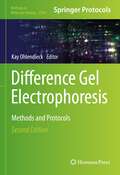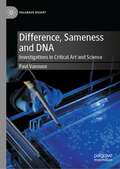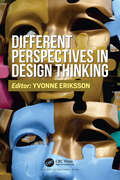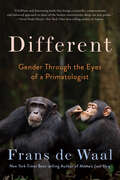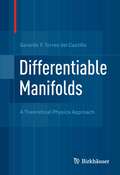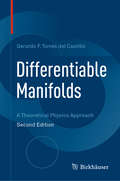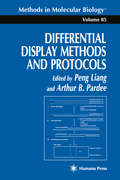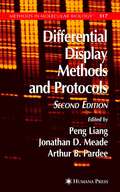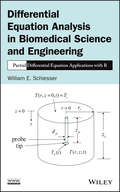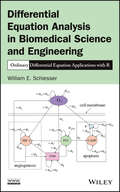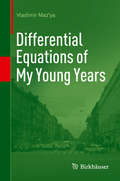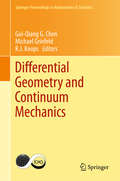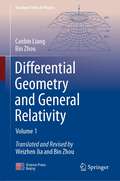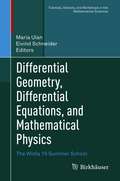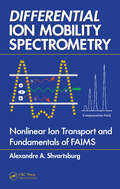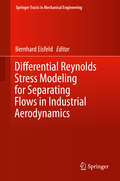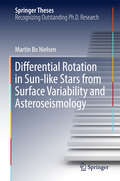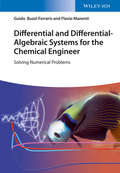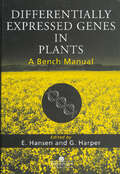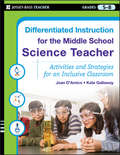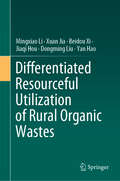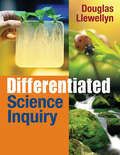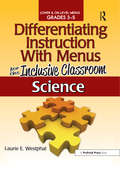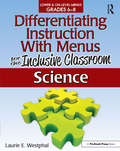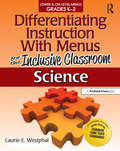- Table View
- List View
Difference Gel Electrophoresis: Methods and Protocols (Methods in Molecular Biology #2596)
by Kay OhlendieckThe second edition of this volume provides a comprehensive update of this key method on gel-based proteomics. Chapters present an introduction into the development of methods on principles of differential protein labeling and two-dimensional gel electrophoresis, techniques on optimized proteomic workflows using advanced mass spectrometry for protein identification, and the application of those methods in basic biological research, pathobiology and applied biomarker discovery. Written in the highly successful Methods in Molecular Biology series format, chapters include introductions to their respective topics, lists of the necessary materials and reagents, step-by-step readily reproducible laboratory protocols, and tips on troubleshooting and avoiding known pitfalls. Authoritative and cutting-edge, Difference Gel Electrophoresis: Methods and Protocols, Second Edition aims to ensure successful results in the further study of this vital field.
Difference, Sameness and DNA: Investigations in Critical Art and Science (Palgrave BioArt)
by Paul VanouseThis book chronicles over two decades of critical, artistic investigations by Paul Vanouse. His bio-media artwork utilizes the tools of the life sciences reflexively, to challenge tropes and cultural politics surrounding DNA, biotechnology, and life itself. DNA has been called a “Truth Machine”, “God’s Blueprint”, the “Code of Codes” and the “Book of Life”. Vanouse’s work explores questions at the heart of such evocative metaphor and hyperbole: how does DNA link us together, how does it differentiate us and how are the grand metaphors, which grant DNA complete centrality, misconstruing the complexity of life. Furthermore, how do technologies of genetic typing and identification fit within a broader cultural and political history of difference making, particularly the construction of race. Melding critical theory, artist’s manifesto, participatory observation and histories of the sciences, this book offers insight into both an artistic practice and the bio-techno-sciences it interrogates.
Different Perspectives in Design Thinking
by Yvonne ErikssonGlobalization and digitalization are buzz words in contemporary society. They affect both our private and our professional lives. Society has become more diverse with easier access to information and to virtual platforms that gives us opportunity to be in touch with colleagues, friends, family, etc. at any time. A complex environment is emerging wherein internet of things and big data are being integrated with products, production systems, healthcare, and daily activity and play an important part in decision making. This has an impact on future designs and the role of designers. Responsible designers with a holistic perspective are needed.The book highlights several aspects of design thinking such as Information Design and Critical Design. The meaning of culture, gender and disabilities are also discussed. The functions of Information Design are changing from ‘showing the way’, instruction manuals and graphic design. It will affect among others, healthcare technology, smart products and Industry 4.0. Design thinking perspective that includes users from the entire chain and from the producer to the end user of the product or service, is needed. This will also require gender and culture issues to be taken into consideration in designing products and services. Design thinking methods and critical aspects of design will contribute to an inclusive society.
Different: Gender Through The Eyes Of A Primatologist
by Frans de WaalLonglisted for the PEN/E.O. Wilson Literary Science Writing Award "Every new book by Frans de Waal is a cause for excitement, and this one is no different. A breath of fresh air in the cramped debate about the differences between men and women. Fascinating, nuanced, and very timely." —Rutger Bregman, author of Humankind: A Hopeful History In Different, world-renowned primatologist Frans de Waal draws on decades of observation and studies of both human and animal behavior to argue that despite the linkage between gender and biological sex, biology does not automatically support the traditional gender roles in human societies. While humans and other primates do share some behavioral differences, biology offers no justification for existing gender inequalities. Using chimpanzees and bonobos to illustrate this point—two ape relatives that are genetically equally close to humans—de Waal challenges widely held beliefs about masculinity and femininity, and common assumptions about authority, leadership, cooperation, competition, filial bonds, and sexual behavior. Chimpanzees are male-dominated and violent, while bonobos are female-dominated and peaceful. In both species, political power needs to be distinguished from physical dominance. Power is not limited to the males, and both sexes show true leadership capacities. Different is a fresh and thought-provoking approach to the long-running debate about the balance between nature and nurture, and where sex and gender roles fit in. De Waal peppers his discussion with details from his own life—a Dutch childhood in a family of six boys, his marriage to a French woman with a different orientation toward gender, and decades of academic turf wars over outdated scientific theories that have proven hard to dislodge from public discourse. He discusses sexual orientation, gender identity, and the limitations of the gender binary, exceptions to which are also found in other primates. With humor, clarity, and compassion, Different seeks to broaden the conversation about human gender dynamics by promoting an inclusive model that embraces differences, rather than negating them.
Differentiable Manifolds
by Gerardo F. Torres del CastilloThis textbook delves into the theory behind differentiable manifolds while exploring various physics applications along the way. Included throughout the book are a collection of exercises of varying degrees of difficulty. Differentiable Manifolds is intended for graduate students and researchers interested in a theoretical physics approach to the subject. Prerequisites include multivariable calculus, linear algebra, and differential equations and a basic knowledge of analytical mechanics.
Differentiable Manifolds: A Theoretical Physics Approach
by Gerardo F. Torres del CastilloThis textbook delves into the theory behind differentiable manifolds while exploring various physics applications along the way. Included throughout the book are a collection of exercises of varying degrees of difficulty. Differentiable Manifolds is intended for graduate students and researchers interested in a theoretical physics approach to the subject. Prerequisites include multivariable calculus, linear algebra, and differential equations and a basic knowledge of analytical mechanics.
Differential Display Methods and Protocols
by Peng Liang Arthur B. PardeeDrs. Peng Liang and Arthur B. Pardee assemble for the first time a comprehensive review of the state of the art of their powerful new methodology and practical applications. The book's pioneering contributors describe all the major elements of this novel technology, including both RAP-PCR and DD using fluorescence detection, as well as their powerful strategy for identifying and cloning family-specific genes. They also provide numerous examples in which differentially expressed genes were successfully identified in diverse biological systems ranging from plants to songbirds to humans.
Differential Display Methods and Protocols
by Peng Liang Arthur B. Pardee Jonathan MeadeBased on a new mathematical model of differential display (DD), this updated second edition takes advantage of automation, as well as digital data acquisition and analysis. The authors explain and highlight all the recent methodological refinements, including automated liquid handling of hundreds of DD PCR reaction setups combined with capillary electrophoresis, a prototype computer program to automatically allow positive band identification from a fluorescence differential display (FD) image, and restriction fragment-based DD screenings. Other improvements discussed are the combining of DD and DNA microarrays by reducing the complexity of cDNA probes while increasing the sensitivity of detection, and a DD approach to detect prokaryotic mRNA expression. The authors also demonstrate the power of DD technology with a collection of outstanding examples of DD applications and detailed experimental procedures. The elegant studies described here have led to the discovery of many important genes involved in viral infection, Prion disease, cancer, ovulation, circadian clock, floral color, transcription repression gene silencing, mRNA polymorphism, and protein-RNA interaction.
Differential Equation Analysis in Biomedical Science and Engineering
by William E. SchiesserFeatures a solid foundation of mathematical and computational tools to formulate and solve real-world PDE problems across various fieldsWith a step-by-step approach to solving partial differential equations (PDEs), Differential Equation Analysis in Biomedical Science and Engineering: Partial Differential Equation Applications with R successfully applies computational techniques for solving real-world PDE problems that are found in a variety of fields, including chemistry, physics, biology, and physiology. The book provides readers with the necessary knowledge to reproduce and extend the computed numerical solutions and is a valuable resource for dealing with a broad class of linear and nonlinear partial differential equations.The author's primary focus is on models expressed as systems of PDEs, which generally result from including spatial effects so that the PDE dependent variables are functions of both space and time, unlike ordinary differential equation (ODE) systems that pertain to time only. As such, the book emphasizes details of the numerical algorithms and how the solutions were computed. Featuring computer-based mathematical models for solving real-world problems in the biological and biomedical sciences and engineering, the book also includes:R routines to facilitate the immediate use of computation for solving differential equation problems without having to first learn the basic concepts of numerical analysis and programming for PDEsModels as systems of PDEs and associated initial and boundary conditions with explanations of the associated chemistry, physics, biology, and physiologyNumerical solutions of the presented model equations with a discussion of the important features of the solutionsAspects of general PDE computation through various biomedical science and engineering applicationsDifferential Equation Analysis in Biomedical Science and Engineering: Partial Differential Equation Applications with R is an excellent reference for researchers, scientists, clinicians, medical researchers, engineers, statisticians, epidemiologists, and pharmacokineticists who are interested in both clinical applications and interpretation of experimental data with mathematical models in order to efficiently solve the associated differential equations. The book is also useful as a textbook for graduate-level courses in mathematics, biomedical science and engineering, biology, biophysics, biochemistry, medicine, and engineering.
Differential Equation Analysis in Biomedical Science and Engineering
by William E. SchiesserFeatures a solid foundation of mathematical and computational tools to formulate and solve real-world ODE problems across various fieldsWith a step-by-step approach to solving ordinary differential equations (ODEs), Differential Equation Analysis in Biomedical Science and Engineering: Ordinary Differential Equation Applications with R successfully applies computational techniques for solving real-world ODE problems that are found in a variety of fields, including chemistry, physics, biology, and physiology. The book provides readers with the necessary knowledge to reproduce and extend the computed numerical solutions and is a valuable resource for dealing with a broad class of linear and nonlinear ordinary differential equations.The author's primary focus is on models expressed as systems of ODEs, which generally result by neglecting spatial effects so that the ODE dependent variables are uniform in space. Therefore, time is the independent variable in most applications of ODE systems. As such, the book emphasizes details of the numerical algorithms and how the solutions were computed. Featuring computer-based mathematical models for solving real-world problems in the biological and biomedical sciences and engineering, the book also includes:R routines to facilitate the immediate use of computation for solving differential equation problems without having to first learn the basic concepts of numerical analysis and programming for ODEsModels as systems of ODEs with explanations of the associated chemistry, physics, biology, and physiology as well as the algebraic equations used to calculate intermediate variablesNumerical solutions of the presented model equations with a discussion of the important features of the solutionsAspects of general ODE computation through various biomolecular science and engineering applicationsDifferential Equation Analysis in Biomedical Science and Engineering: Ordinary Differential Equation Applications with R is an excellent reference for researchers, scientists, clinicians, medical researchers, engineers, statisticians, epidemiologists, and pharmacokineticists who are interested in both clinical applications and interpretation of experimental data with mathematical models in order to efficiently solve the associated differential equations. The book is also useful as a textbook for graduate-level courses in mathematics, biomedical science and engineering, biology, biophysics, biochemistry, medicine, and engineering.
Differential Equations of My Young Years
by Vladimir Maz'YaVladimir Maz'ya (born 1937) is an outstanding mathematician who systematically made fundamental contributions to a wide array of areas in mathematical analysis and in the theory of partial differential equations. In this fascinating book he describes the first thirty years of his life. He starts with the story of his family, speaks about his childhood, high school and university years, describe his formative years as a mathematician. Behind the author's personal recollections, with his own joys, sorrows and hopes, one sees a vivid picture of the time. He speaks warmly about his friends, both outside and inside mathematics. The author describes the awakening of his passion for mathematics and his early achievements. He mentions a number of mathematicians who influenced his professional life. The book is written in a readable and inviting way sometimes with a touch of humor. It can be of interest for a very broad readership.
Differential Geometry and Continuum Mechanics
by Michael Grinfeld Gui-Qiang G. Chen R. J. KnopsThis book examines the exciting interface between differential geometry and continuum mechanics, now recognised as being of increasing technological significance. Topics discussed include isometric embeddings in differential geometry and the relation with microstructure in nonlinear elasticity, the use of manifolds in the description of microstructure in continuum mechanics, experimental measurement of microstructure, defects, dislocations, surface energies, and nematic liquid crystals. Compensated compactness in partial differential equations is also treated. The volume is intended for specialists and non-specialists in pure and applied geometry, continuum mechanics, theoretical physics, materials and engineering sciences, and partial differential equations. It will also be of interest to postdoctoral scientists and advanced postgraduate research students. These proceedings include revised written versions of the majority of papers presented by leading experts at the ICMS Edinburgh Workshop on Differential Geometry and Continuum Mechanics held in June 2013. All papers have been peer reviewed.
Differential Geometry and General Relativity: Volume 1 (Graduate Texts in Physics)
by Bin Zhou Canbin LiangThis book, the first in a three-volume set, explains general relativity using the mathematical tool of differential geometry. The book consists of ten chapters, the first five of which introduce differential geometry, which is widely applicable even outside the field of relativity. Chapter 6 analyzes special relativity using geometric language. In turn, the last four chapters introduce readers to the fundamentals of general relativity. Intended for beginners, this volume includes numerous exercises and worked-out example in each chapter to facilitate the learning experience. Chiefly written for graduate-level courses, the book’s content will also benefit upper-level undergraduate students, and can be used as a reference guide for practicing theoretical physicists.
Differential Geometry, Differential Equations, and Mathematical Physics: The Wisła 19 Summer School (Tutorials, Schools, and Workshops in the Mathematical Sciences)
by Eivind Schneider Maria UlanThis volume presents lectures given at the Wisła 19 Summer School: Differential Geometry, Differential Equations, and Mathematical Physics, which took place from August 19 - 29th, 2019 in Wisła, Poland, and was organized by the Baltic Institute of Mathematics. The lectures were dedicated to symplectic and Poisson geometry, tractor calculus, and the integration of ordinary differential equations, and are included here as lecture notes comprising the first three chapters. Following this, chapters combine theoretical and applied perspectives to explore topics at the intersection of differential geometry, differential equations, and mathematical physics. Specific topics covered include:Parabolic geometryGeometric methods for solving PDEs in physics, mathematical biology, and mathematical financeDarcy and Euler flows of real gasesDifferential invariants for fluid and gas flowDifferential Geometry, Differential Equations, and Mathematical Physics is ideal for graduate students and researchers working in these areas. A basic understanding of differential geometry is assumed.
Differential Ion Mobility Spectrometry: Nonlinear Ion Transport and Fundamentals of FAIMS
by Alexandre A. ShvartsburgOver the last decade, scientific and engineering interests have been shifting from conventional ion mobility spectrometry (IMS) to field asymmetric waveform ion mobility spectrometry (FAIMS). Differential Ion Mobility Spectrometry: Nonlinear Ion Transport and Fundamentals of FAIMS explores this new analytical technology that separates and character
Differential Reynolds Stress Modeling for Separating Flows in Industrial Aerodynamics
by Bernhard EisfeldThis book presents recent progress in the application of RANS turbulence models based on the Reynolds stress transport equations. A variety of models has been implemented by different groups into different flow solvers and applied to external as well as to turbo machinery flows. Comparisons between the models allow an assessment of their performance in different flow conditions. The results demonstrate the general applicability of differential Reynolds stress models to separating flows in industrial aerodynamics.
Differential Rotation in Sun-like Stars from Surface Variability and Asteroseismology
by Martin Bo NielsenIn his PhD dissertation Martin Bo Nielsen performs observational studies of rotation in stars like the Sun. The interior rotation in stars is thought to be one of the driving mechanisms of stellar magnetic activity, but until now this mechanism was unconstrained by observational data. NASA's Kepler space mission provides high-precision observations of Sun-like stars which allow rotation to be inferred using two independent methods: asteroseismology measures the rotation of the stellar interior, while the brightness variability caused by features on the stellar surface trace the rotation of its outermost layers. By combining these two techniques Martin Bo Nielsen was able to place upper limits on the variation of rotation with depth in five Sun-like stars. These results suggest that the interior of other Sun-like stars also rotate in much the same way as our own Sun.
Differential and Differential-Algebraic Systems for the Chemical Engineer
by Guido Buzzi-Ferraris Flavio ManentiThis fourth in a suite of five practical guides is an engineer's companion to using numerical methods for the solution of complex mathematical problems. It explains the theory behind current numerical methods and shows in a step-by-step fashion how to use them.The volume focuses on differential and differential-algebraic systems, providing numerous real-life industrial case studies to illustrate this complex topic. It describes the methods, innovative techniques and strategies that are all implemented in a freely available toolbox called BzzMath, which is developed and maintained by the authors and provides up-to-date software tools for all the methods described in the book. Numerous examples, sample codes, programs and applications are taken from a wide range of scientific and engineering fields, such as chemical engineering, electrical engineering, physics, medicine, and environmental science. As a result, engineers and scientists learn how to optimize processes even before entering the laboratory.With additional online material including the latest version of BzzMath Library, installation tutorial, all examples and sample codes used in the book and a host of further examples.
Differentially Expressed Genes In Plants: A Bench Manual
by Axel Kornerup HansenThe analysis of changes in gene activity in tissues and cells of plants is a way of measuring developmental and environmental responses. This volume provides detailed accounts of new and established techniques used to carry out such analyses.
Differentiated Instruction for the Middle School Science Teacher
by Joan D'Amico Kate GallawayAn indispensable guide for middle school science teachers who have inclusive classrooms The third volume in the Differentiated Instruction series, Differentiated Instruction for the Middle School Science Teacher offers teachers proven techniques for designing and delivering effective science instruction, measuring success, getting students to work together, and collaborating with other professionals. The ready-to-use activities are tied to core curriculum standards for middle school students and each lesson incorporates adaptations for students with different learning needs. Includes strategies for teaching a standards-based science curriculum Contains a wealth of activities that can be adapted for learners of all abilities Offers information for delivering effective instruction, measuring success, and student collaboration The authors, both experienced teachers, offer a range of techniques, such as station/group activities, enrichment activities, and modifications for students with specific disabilities.
Differentiated Resourceful Utilization of Rural Organic Wastes
by Beidou Xi Mingxiao Li Xuan Jia Jiaqi Hou Dongming Liu Yan HaoThis book systematically introduces the key technologies for differentiated resourceful utilization of rural organic wastes based on high-efficiency anaerobic fermentation and bio-augmented composting, and discusses differentiating sources of organic wastes, integrating recycling technologies, developing key equipment, and researching management mechanisms. In addition, it describes the development of viable techniques and low-pollution, low-cost, and low-maintenance equipment. It also includes the technical specifications for the differentiated resourceful utilization of rural organic wastes and presents the energy-fertilizer integrated resourceful utilization method for rural organic wastes. Providing technological insights into improving the resourceful utilization level of rural organic wastes, this book is a valuable reference resource for administrative staff, researchers in the field of environmental protection, and technicians in enterprises involved in the treatment and disposal of solid wastes.
Differentiated Science Inquiry
by Douglas J. LlewellynIgnite science learning with differentiated instruction One type of science instruction does not fit all. Best-selling author Douglas Llewellyn gives teachers standards-based strategies for differentiating science education to more effectively meet the needs of all students. This book takes the concept of inquiry-based science instruction to a deeper level, includes a compelling case study, and demonstrates: Methods for determining when and how to provide students with more choices, thereby increasing their ownership and motivation Ways to implement differentiated science inquiry in the main areas of science instruction Strategies for successfully managing the classroom
Differentiating Instruction With Menus for the Inclusive Classroom: Science (Grades 3-5)
by Laurie E. WestphalDifferentiating Instruction With Menus for the Inclusive Classroom: Science for grades 3-5 offers teachers everything they need to create a student-centered learning environment based on choice. This book provides six different types of menus that students can use to select exciting products that they will develop so teachers can assess what has been learned—instead of using a traditional worksheet format. Topics addressed include physical science, biological science, Earth science, and tools scientists use.Differentiating Instruction With Menus for the Inclusive Classroom: Science provides numerous types of leveled menus that lower and on-level elementary-aged students can use to demonstrate learning through a method of their choice. Menus with similar formats but geared towards varying ability levels allow teachers to differentiate easily. Using the creative and challenging choices found in Tic-Tac-Toe menus, List menus, 2-5-8 menus, Three Shape menus, Baseball menus, and Game Show menus, students will look forward to sharing their newfound knowledge throughout the year. Also included are specific guidelines for products, rubrics for assessing student products, and teacher introduction pages for each menu. This is a must-have for any teacher wanting to differentiate for a wide range of learners!Grades 3-5
Differentiating Instruction With Menus for the Inclusive Classroom: Science (Grades 6-8)
by Laurie E. WestphalDifferentiating Instruction With Menus for the Inclusive Classroom: Science for grades 6-8 offers teachers who have multiple ability levels in one classroom everything they need to create a student-centered learning environment based on choice. For each topic covered, there are two menus that look similar but contain differentiated content: one menu for students working on grade level and the other for students working below grade level. Using the creative, challenging choices found in Tic-Tac-Toe menus, List menus, 2-5-8 menus, and Game Show menus, students will demonstrate their knowledge with unique, exciting products. Also included are specific guidelines for products, assessment rubrics, and teacher introduction pages for each menu. These menus can also be used in conjunction with the Differentiating Instruction With Menus series (for students working above grade level) for three tiers of complementary menus.Grades 6-8
Differentiating Instruction With Menus for the Inclusive Classroom: Science (Grades K-2)
by Laurie E. WestphalDifferentiating Instruction With Menus for the Inclusive Classroom: Science for grades K-2 offers teachers everything needed to create a student-centered learning environment based on choice. This book provides seven different types of menus that students can use to select exciting products that they will develop so teachers can assess what has been learned instead of using a traditional worksheet format. Topics addressed include life sciences, Earth sciences, and physical sciences. Differentiating Instruction With Menus for the Inclusive Classroom: Science provides numerous types of leveled menus that lower and on-level primary-age students can use to select exciting products to demonstrate learning. Menus with similar formats but geared toward varying ability levels allow teachers to differentiate easily. Using the creative and challenging choices found in Meal menus, Tic-Tac-Toe menus, Target-Based List menus, 2-5-8 menus, Give Me 5 menus, Three-Shape menus, and Pick 3 menus, students will look forward to sharing their newfound knowledge throughout the year. Also included are specific guidelines for products, rubrics for assessing student products, and teacher introduction pages for each menu. This is a must-have for any teacher wanting to differentiate for a wide range of learners!Grades K-2
